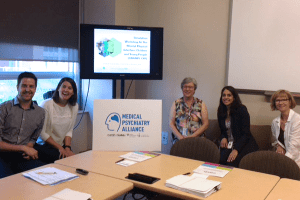By Stephanie Sliekers, Coordinator, CAMH Simulation
Continuing our series looking at the international simulation collaboration CAMH Education is leading, project co-ordinator Stephanie Sliekers gives us a little background on how simulation works.
It Takes a Team of People–Both Real and Simulated
Simulation is the replication of something real for the purposes of education and training. In health care, simulation gives clinicians high-impact learning experiences that don’t risk harming actual clients or patients.
The replication part of simulation is important—and it is part of what I do as the simulation project co-ordinator at CAMH. We know that health care professionals learn from simulated events because they offer an opportunity to reflect—on clinical skills, team work, decision-making and so on. For that reflection to be relevant, the situation has to feel like the real thing.
But making a simulated environment look and feel real isn’t easy. And in order to run the Simulation Workshop at the Mental-Physical Interface (SWAMPI) courses in collaboration with the Maudsley Simulation in Toronto back in June, our teams had to work hard behind the scenes to design and execute a simulation that would facilitate specific learning outcomes.
One scenario in particular required a lot of planning. It simulated a real client’s actual journey from the emergency room to a psychiatric institution. Jean-Pierre was admitted to hospital after jumping from his third-floor apartment building. He became increasingly agitated and was soon transferred to a psychiatric hospital where he began to experience chest pains. The goal of this scenario was to enhance the learner’s awareness and knowledge of how to assess and manage escalation and medical deterioration.
To replicate this event in a simulation, we had to consider a few things. How do we simulate the nuanced symptoms of psychological distress, and the—while maintaining continuity—simulate chest pains and Jean-Pierre’s changing heart rate and blood pressure?
Our team, in collaboration with the faculty from the Maudsley, trained the actor—an education specialist with simulation acting experience—to play the role of Jean-Pierre. He was well attuned to the learning objectives of the scenario, the clinical roles involved and the context of interprofessional care emphasized within the scenarios. We provided him with Jean-Pierre’s detailed medical history and lived experience, and instructions on what affect to demonstrate. With all of these details provided in advance, Jean-Pierre could communicate with the learners just as he would in a clinical situation—but with a clear direction and learning goal.

As for the manikin, it gave us the ability to control Jean-Pierre’s physical symptoms. Learners could still interact with Jean-Pierre (our education specialist sat in an adjacent room and spoke through a speaker projecting from the manikin’s mouth). But what the manikin provided that our educational specialist could not was the opportunity for learners to complete a thorough physical investigation, with an EEG machine, oxygen mask and pulsoximeter, while a nearby faculty member controlled Jean-Pierre’s changing vital signs.
In debriefing Jean-Pierre’s scenario, we heard from learners that the scenario was very much like those they encounter in practice. It was a chance to reflect not only on what happened in the simulation, but also on what happens in their practice on a daily basis.
In a follow-up blog, we’ll provide more information on the debriefs and the value of having diverse professionals represented. But what I can say right now is that the debriefing asked: “How did it feel?”
Our team of simulation educators knew we had done our job when the learners’ responses were: “Real!”
For more information about the SWAMPI evaluation have a click on these CAMH Education and International Mental Health Simulation Collaboration posts:
- Part 1: It all started with a little note—An International Collaboration to Offer Simulation Education at the Mental-Physical Interface
- Part 3: Realizing the Potential of Diversity in Interprofessional Health Care Teams: Simulation Education as an Opportunity for Shared Learning
- Part 4: 5Qs with A Simulation Team Research Analyst
- Part 5: That's a Wrap!
Want more education info, innovation and stories? Follow CAMH Education on Twitter: @camhEdu
